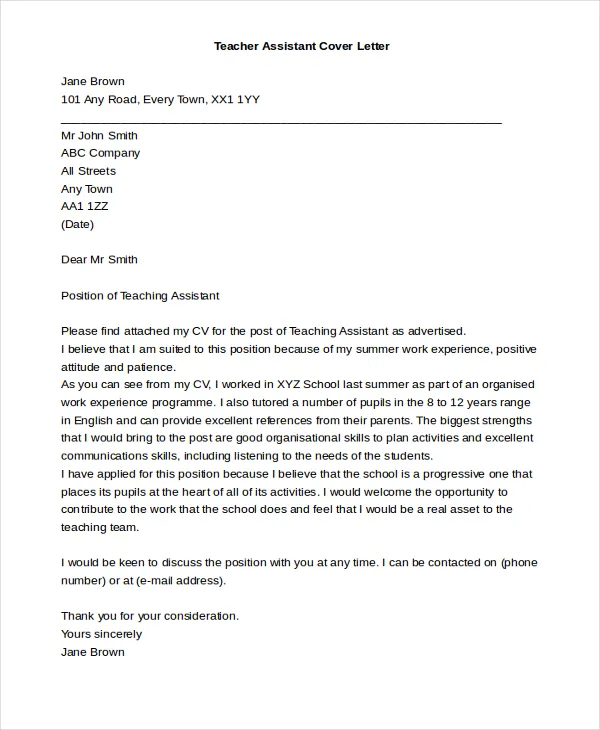What is a Teaching Assistant Cover Letter
A Teaching Assistant cover letter is a crucial document that accompanies your resume when applying for a Teaching Assistant position. It serves as your first impression, allowing you to introduce yourself, showcase your qualifications, and express your enthusiasm for the role. Unlike a resume, which provides a factual overview of your experience, a cover letter gives you the opportunity to elaborate on your skills, explain your motivations, and demonstrate why you are the ideal candidate. A well-crafted cover letter is essential for making a positive impression on potential employers and increasing your chances of landing an interview.
Understanding the Purpose of the Cover Letter
The primary purpose of a Teaching Assistant cover letter is to persuade the hiring manager that you are a good fit for the position. It should highlight your relevant skills and experience, demonstrate your understanding of the role, and express your genuine interest in the institution. The cover letter allows you to personalize your application, explaining why you are interested in the specific opportunity and what you can bring to the team. Moreover, it provides a platform to address any potential concerns or gaps in your resume, such as a career change or a lack of formal teaching experience, thereby making your application more compelling and increasing your chances of securing an interview.
Key Components of a Teaching Assistant Cover Letter
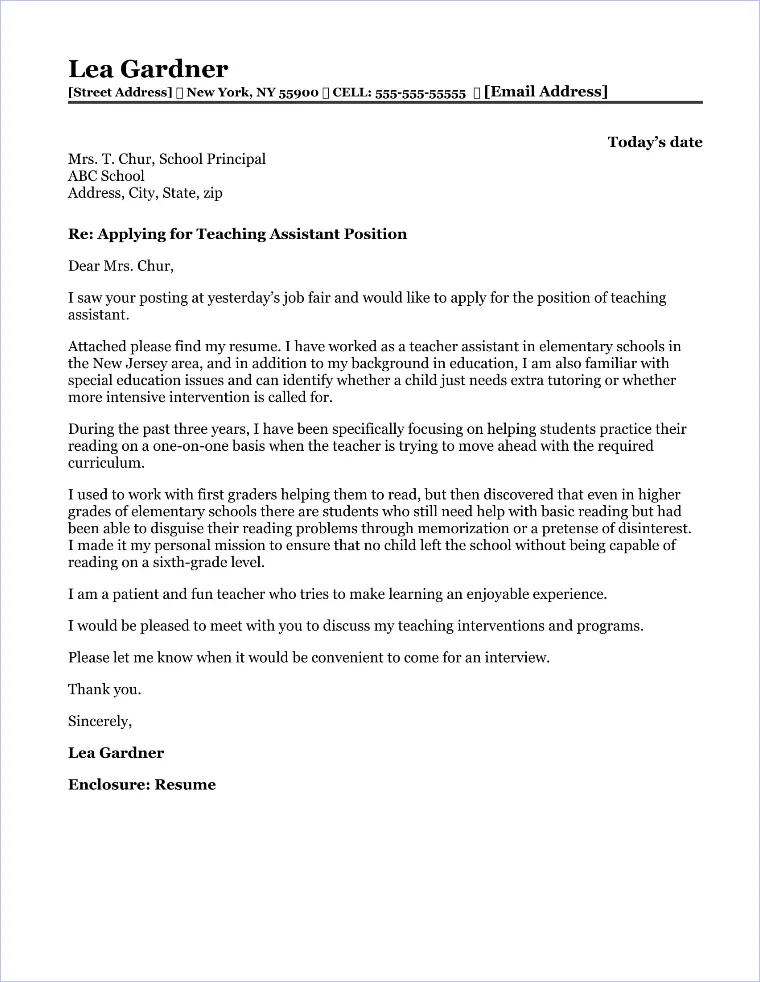
A strong Teaching Assistant cover letter follows a clear structure and includes several key components. These components work together to present a comprehensive and persuasive case for your candidacy. By incorporating these elements, you can create a cover letter that effectively communicates your qualifications and enthusiasm to potential employers.
Contact Information and Date
At the top of your cover letter, include your full name, address, phone number, and email address. This information should be clearly displayed to allow the hiring manager to easily contact you. Below your contact information, include the date of the letter. Using a professional format ensures that your contact information is easily accessible and presents a polished appearance. A properly formatted header is an indication of your attention to detail and professionalism.
Hiring Manager’s Information
If possible, address the cover letter to a specific person, such as the hiring manager or the professor in charge of the program. Research the institution’s website or use LinkedIn to find the name and title of the appropriate contact. Addressing the letter to a specific person demonstrates that you have taken the time to learn about the opportunity and shows your initiative. If you are unable to find a specific name, you can use a generic greeting such as “Dear Hiring Committee.”
Salutation
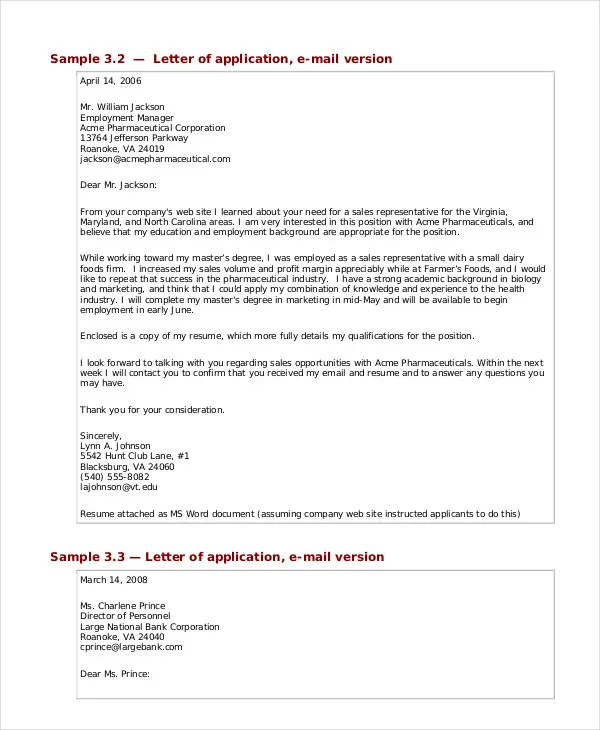
Begin your cover letter with a professional salutation. If you know the hiring manager’s name, use “Dear Mr./Ms. [Last Name].” If you do not know the name, use “Dear Hiring Manager” or “Dear [Department Name] Hiring Committee.” Avoid informal greetings like “Hello” or “Hi.” A professional salutation sets the tone for the rest of the letter and conveys your respect for the hiring manager and the institution.
Opening Paragraph
The opening paragraph should immediately grab the reader’s attention. State the specific position you are applying for and how you learned about the opportunity. Briefly mention your key qualifications and express your enthusiasm for the position. Consider including a brief statement about why you are interested in the institution and what you hope to achieve in the role. A strong opening sets the stage for a compelling cover letter and encourages the reader to continue reading.
Highlighting Relevant Skills and Experience
This is the most important section of your cover letter. Here, you will showcase your relevant skills and experiences that make you a strong candidate for the Teaching Assistant position. Provide specific examples from your background to demonstrate your ability to succeed in the role. Focus on how your skills and experiences align with the requirements and expectations outlined in the job description. The details that you share in this section help to show the value that you could bring to the teaching assistant position.
Showcasing Educational Background
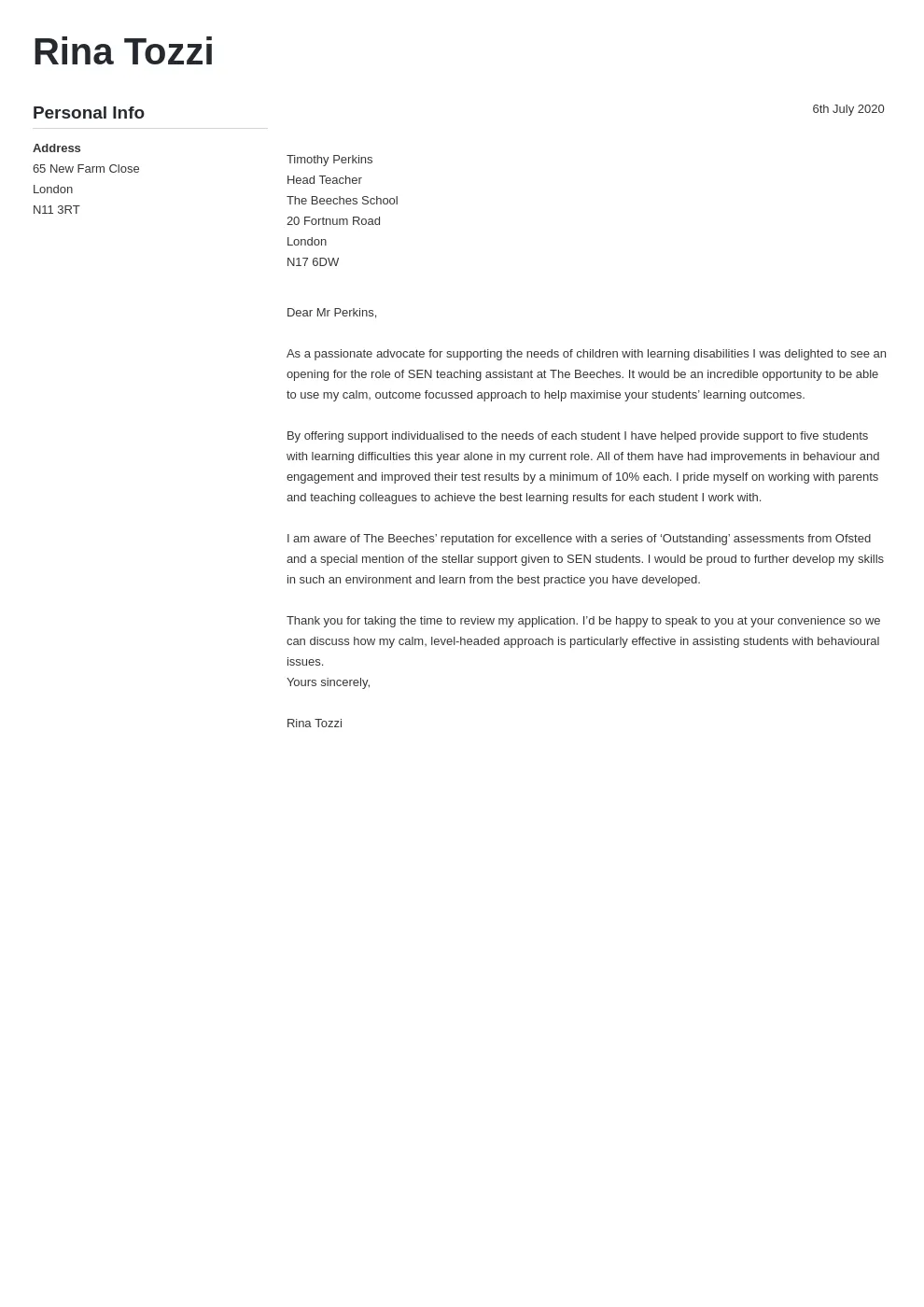
Detail your educational background, including your degree, major, and any relevant coursework or honors. If you are currently pursuing a degree, mention your expected graduation date. Highlight any academic achievements or relevant projects that demonstrate your knowledge and skills in the subject area. Providing this information helps establish your academic credentials and sets you up as someone with an established skill set to fulfill the teaching assistant role.
Emphasizing Teaching and Mentoring Experience
If you have any prior teaching or mentoring experience, be sure to highlight it. Describe your roles, responsibilities, and the outcomes of your work. Mention any specific teaching methods or strategies you have used, as well as any experience working with students. Quantify your accomplishments whenever possible. If you don’t have formal teaching experience, emphasize transferable skills such as tutoring, leading workshops, or presenting to groups. This information helps to demonstrate your ability to effectively instruct and guide students.
Demonstrating Communication and Interpersonal Skills
Teaching Assistants need to be able to communicate effectively with students, faculty, and staff. Provide examples of your strong communication and interpersonal skills. Describe situations where you successfully communicated complex information, resolved conflicts, or worked collaboratively with others. Highlight your ability to listen, understand, and respond to the needs of others. Include details that highlight your ability to build rapport with students. Such details offer a picture of your abilities to effectively fulfill the requirements of the role.
Expressing Enthusiasm and Passion
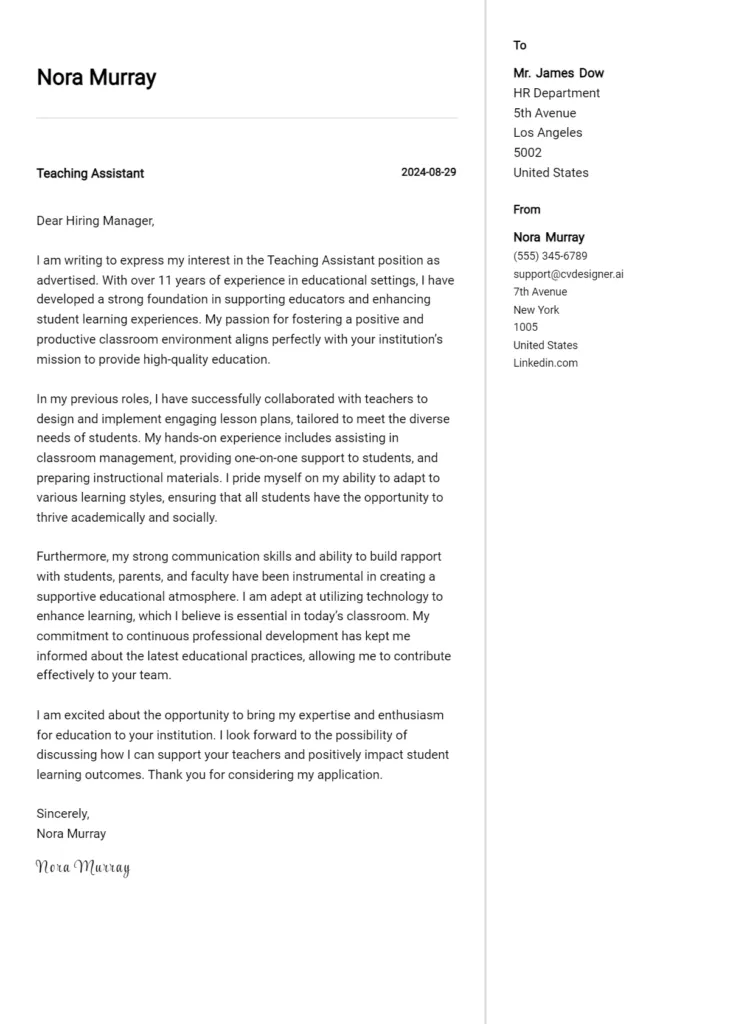
Convey your enthusiasm for the position and the institution. Explain why you are interested in becoming a Teaching Assistant and what motivates you to help students learn. Share your passion for the subject matter and how you hope to contribute to the learning environment. The best way to do this is to be sincere, and let your passion for education shine through in your writing. Doing so creates a compelling narrative and helps you stand out from other candidates.
Formatting and Structure
The format and structure of your cover letter are crucial for readability and professionalism. A well-formatted letter is easy to read and demonstrates your attention to detail. Following a standardized format will help ensure that your cover letter is professional and easy to navigate.
Font, Spacing, and Length
Use a standard, easy-to-read font such as Times New Roman, Arial, or Calibri, in a size between 11 and 12 points. Ensure that your letter is single-spaced with a blank line between paragraphs. Keep the length of your cover letter concise, ideally one page. Avoid using jargon or overly complex language. Keeping the language simple and the formatting clean will help the reader focus on the content of your letter.
Proofreading and Editing
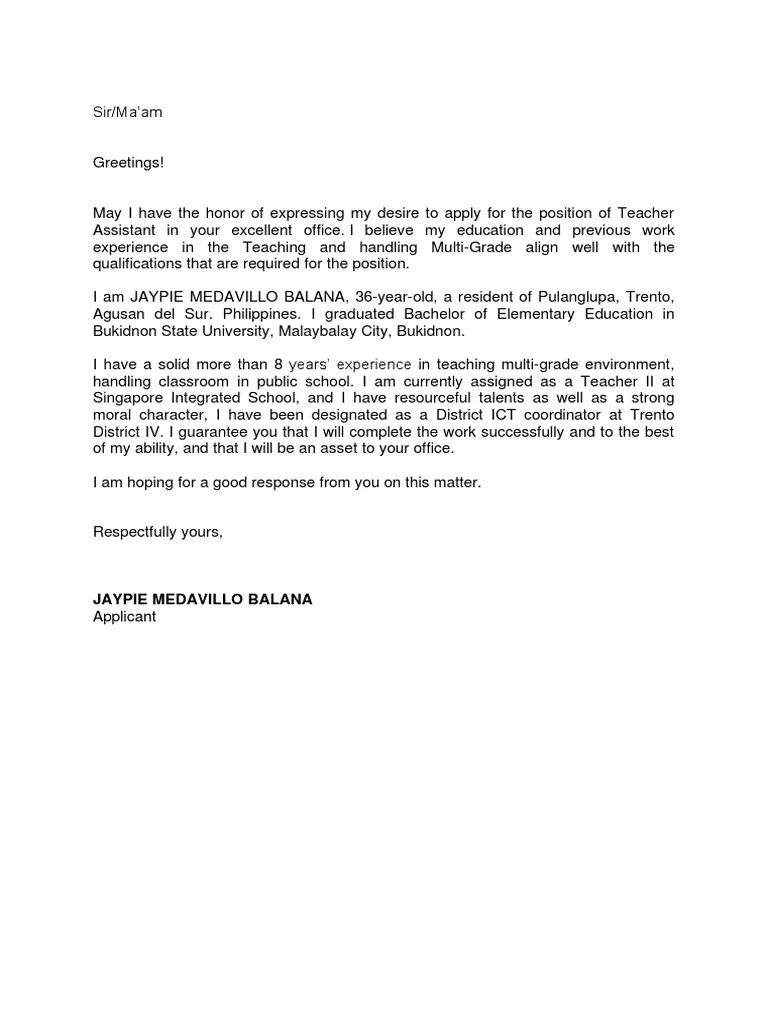
Carefully proofread and edit your cover letter for any grammatical errors, spelling mistakes, or typos. Ask a friend, family member, or career counselor to review your letter as well. Proofreading is critical to ensure that your cover letter is polished and error-free. A letter with errors will immediately hurt your chances.
Call to Action and Closing
The closing of your cover letter is your opportunity to express gratitude and state your availability for an interview. A strong closing leaves a positive final impression and encourages the hiring manager to take the next step.
Expressing Gratitude and Offering Availability
Thank the hiring manager for their time and consideration. Express your enthusiasm for the opportunity and reiterate your interest in the position. State your availability for an interview and provide your contact information again. This will help keep you on the hiring manager’s radar.
Closing and Signature
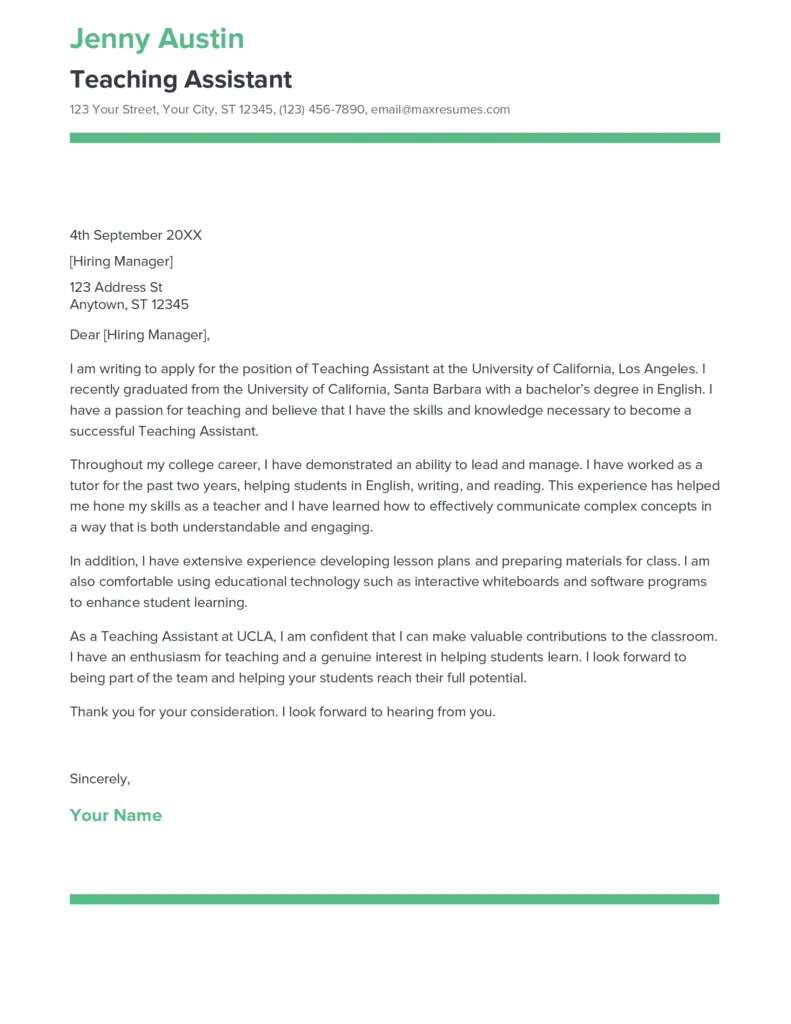
End your cover letter with a professional closing such as “Sincerely,” or “Best regards.” If you are submitting a digital cover letter, type your full name below the closing. If you are submitting a printed cover letter, leave space for your handwritten signature above your typed name. A professional closing and signature complete your cover letter and create a lasting impression.
Cover Letter Samples for Different Scenarios
There are different types of Teaching Assistant positions, and the tone of your cover letter should reflect the specific role and the type of institution. Adapting your letter to the specific opportunity will increase your chances of success. Considering different examples will help you to understand this process.
Cover Letter for Entry-Level Teaching Assistant
If you are applying for an entry-level Teaching Assistant position, highlight your academic achievements, relevant coursework, and any volunteer or extracurricular activities related to education. Focus on your eagerness to learn and your potential to contribute to the classroom. Emphasize your strong work ethic and your ability to follow instructions and work in a team environment. This scenario is a perfect chance to highlight your potential and readiness for the role.
Cover Letter for Experienced Teaching Assistant
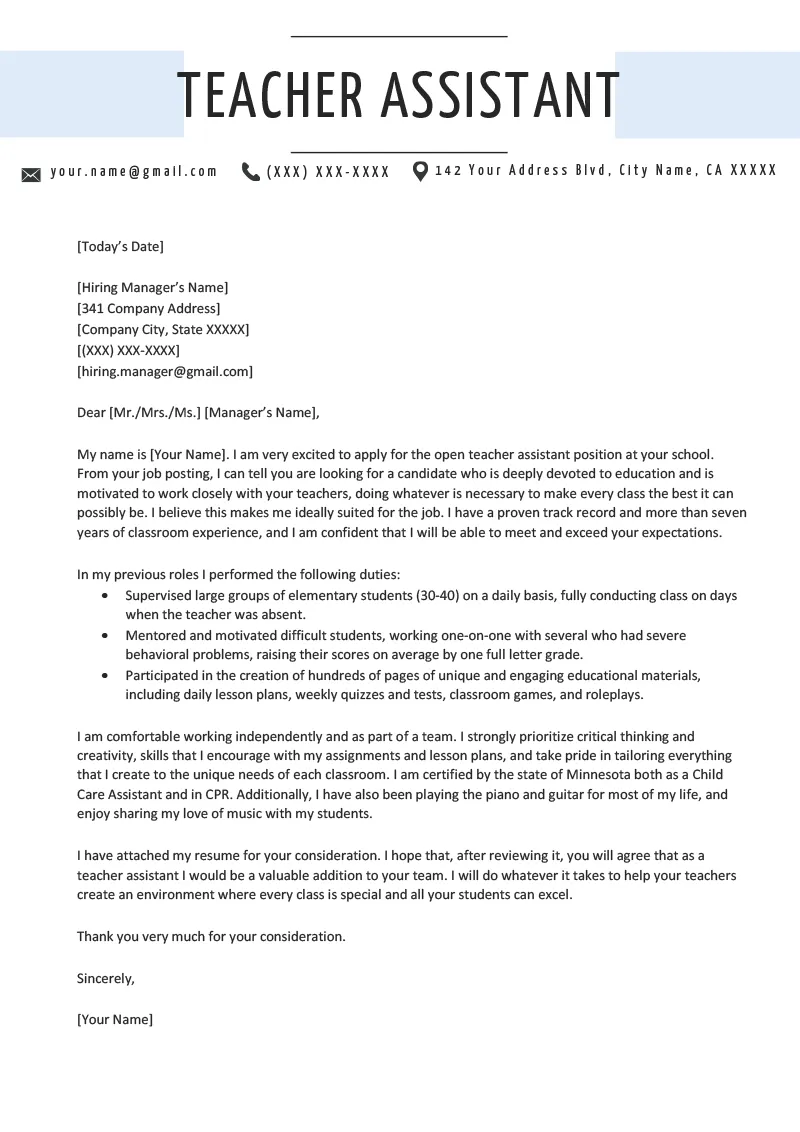
If you have prior experience as a Teaching Assistant or in a related role, emphasize your accomplishments and the impact you made in previous positions. Quantify your results whenever possible. Highlight your skills in lesson planning, classroom management, and student assessment. Include testimonials from previous supervisors or mentors. This kind of cover letter will allow you to showcase the value of your contributions.
Cover Letter for Specific Subject Teaching Assistant
When applying for a Teaching Assistant position in a specific subject area, such as math, science, or English, tailor your cover letter to demonstrate your expertise in that subject. Highlight your knowledge, experience, and passion for the subject matter. Mention any relevant certifications or training you have received. Show how you can use your expertise to help students succeed in the subject area. Demonstrate your skills in order to show your suitability for the position.
Tips for Tailoring Your Cover Letter
Tailoring your cover letter to each specific job application will significantly increase your chances of success. Customization shows that you have taken the time to research the position and the institution, and that you understand the requirements and expectations of the role.
Researching the Institution and Position
Before writing your cover letter, research the institution and the specific position you are applying for. Visit the institution’s website to learn about its mission, values, and academic programs. Review the job description carefully and identify the key skills and qualifications the hiring manager is looking for. Understanding the institution’s and department’s needs will allow you to tailor your letter to highlight your relevant skills and experiences and to show how you can contribute to the institution’s goals.
Customizing Your Letter for Each Application
Avoid using a generic cover letter template. Instead, customize your cover letter for each job application. Address the letter to the specific hiring manager, if possible. Highlight the skills and experiences that are most relevant to the job description. Show how your qualifications align with the needs of the institution. This customization effort helps to show why you are the best fit for the position.
Using Keywords from the Job Description
Carefully review the job description and identify the keywords and phrases used to describe the required skills and qualifications. Incorporate these keywords into your cover letter to demonstrate that you meet the requirements of the position. Using the keywords will help the hiring manager to easily identify your qualifications and see that you are a good match for the role. This practice can also assist with the automated screening systems used by many institutions.
Common Mistakes to Avoid
Avoiding common mistakes will help you to present a professional and persuasive cover letter. Awareness of potential pitfalls is critical to ensure your application stands out for the right reasons. Failing to do so will give the wrong impression and could damage your chance of success.
Typos and Grammatical Errors
Typos and grammatical errors can create a negative impression and undermine your credibility. Always proofread your cover letter carefully before submitting it. Use spell-check and grammar-check tools, and ask someone else to review your letter for you. Make sure that your writing is professional and error-free to demonstrate your attention to detail.
Generic and Uninspired Content
Avoid using generic phrases and clichés. Customize your cover letter to reflect your unique skills, experiences, and enthusiasm for the position. Show the hiring manager that you have a genuine interest in the opportunity and that you are passionate about helping students succeed. A unique voice helps make your cover letter memorable and showcases your strengths.
Neglecting to Proofread
Failing to proofread your cover letter is a common mistake that can cost you the job. Always take the time to proofread your letter carefully, and ask someone else to review it for you. A polished and error-free cover letter is essential for making a positive first impression and demonstrating your attention to detail. Proofreading is an essential part of ensuring that your application looks professional.
Additional Resources
There are a number of online resources available to help you write a strong Teaching Assistant cover letter. Search for templates, examples, and writing guides to help you structure your letter and highlight your qualifications. Use these resources to ensure your cover letter is well-written, professional, and tailored to the specific job you are applying for. Make use of every tool at your disposal to enhance your chances of success.
